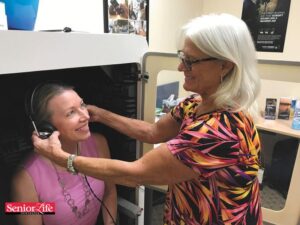MIKE GAFFEY – VIERA VOICE, August 30, 2021

Advances in technology are making a major difference in the lives of millions of American adults suffering from hearing loss.
Today’s hearing aids offer far greater benefits than those made decades ago. And more innovations are on the way to help the one-third of adults between ages 65 and 74 and nearly half of those older than 75 who have trouble hearing.
“It’s really wonderful now in terms of technology,” said Sandra Wagner, a licensed hearing aid specialist and the owner of Personal Hearing Solutions at One Senior Place at 8085 Spyglass Hill Road in Viera.
Modern battery-powered hearing aids are small enough to wear inside or behind a person’s ear. A microphone in the hearing aid detects sound around the wearer, an amplifier makes the sound louder and a receiver sends the amplified sounds into the ear.
“All hearing aids of today are 100 percent digital, 100 percent programmable,” Wagner said.
Hearing aids that fit in the ear are created from a silicone impression of a wearer’s ear canal, Wagner said “These are custom-made like you would make a tooth or a denture,” she said.
Today’s advanced hearing aids can be customized to amplify sounds for a wearer’s unique type of hearing loss. Many have Bluetooth compatibility, a wireless feature that enables a wearer to listen to mobile phones and other devices without feedback or interference.
More hearing aids have rechargeable batteries, eliminating the need to regularly replace button-sized batteries. Some have portable, pocket-sized chargers that can power batteries on the go.
Most advanced hearing aids have smartphone apps that allow users to make adjustments, send calls directly to their hearing aids, contact their hearing care provider or monitor battery life. Some can convert speech into text and translate different languages. Top-line hearing aids have features that mask tinnitus, or ringing in the ears.
Wagner’s clients are thrilled with today’s hearing aids. “Absolutely,” she said. “More natural sounding response, more connectivity to Bluetooth devices, better, more natural sounding hearing. Virtually no feedback anymore, no whistling.”
Other innovations in the works are enhanced eyeglasses that display speech converted to text by a smartphone app, and another app that can isolate a single person’s speech in a crowded, noisy place and deliver it to a user’s hearing aids. Lab researchers also are pursuing gene therapy that might someday restore cells responsible for hearing.
Although 48 million Americans have hearing loss, only 14 percent can afford hearing aids, which cost an average of $5,000, are not covered by Medicare and are seldom covered by insurance.
In an attempt to lower costs, President Biden in July issued an executive order directing the Department of Health and Human Services to come up with rules allowing hearing aids to be sold over the counter.
Wagner, a member of the Florida Hearing Aid Society, said the group’s attorneys have had no success in convincing Medicare or other agencies to cover some hearing aid costs.
For more information about Personal Hearing Solutions, go to PersonalHearing.org or call 321-253-6310 for a free hearing exam.


